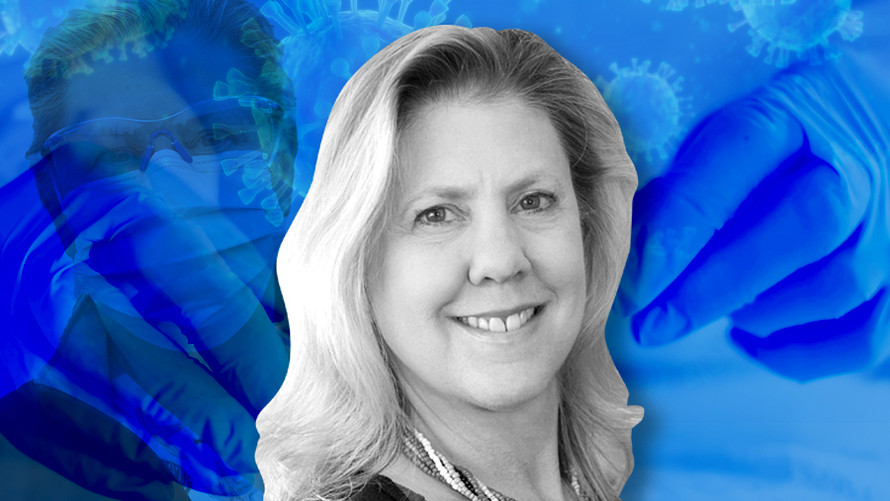
A lung doctor on what she’s learning about coronavirus ‘long haulers’: shortness of breath, fatigue, and depression but also ‘improvement over time’
This interview is the third in a series of conversations MarketWatch is conducting with some of the leading voices in the U.S. on the COVID-19 pandemic.
Back in April, Dr. Dixie Harris and about 100 nurses and doctors from the Intermountain Healthcare hospital system in Utah flew to New York City to work in the region’s overburdened hospitals.
Harris, a pulmonologist who studies e-cigarette vaping, worked for days in a row, caring for COVID-19 patients when the region’s local hospitals were overwhelmed. It was at Southside Hospital in Bay Shore, N.Y., that she started to learn about the virus, about why it’s better to put patients prone, why ventilators aren’t always the best option — and the importance of wearing a face mask.
“One hundred of us went,” she said. “Zero came back positive.”
Back home in the much more sparsely populated state of Utah, cases peaked at 876 on July 9, according to the Utah Department of Health. About 400 people in total have died as a result of a COVID-19 infection. (New York state has reported a total of 430,774 cases and 25,297 deaths as of Aug. 25.) As cases have declined, more of Harris’ focus has turned to patients who had COVID-19 in the spring and are still dealing with myriad health problems and symptoms months later.
Many of these patients in the U.S. call themselves “long haulers.” They have reported fatigue, chest pain and neurological damage.
“One of my first long-hauler patients had symptoms in March,” she said. “Five months later, and this patient was never in the hospital. That’s who I’m mostly seeing: patients who haven’t been in the hospital but continue to have ongoing symptoms.”
MarketWatch: When did you travel to New York?
Dr. Dixie Harris: We were there three weeks in April. It was pretty intense. It was right as the peak was going down, but there were still six times the number of ICU patients or more for the hospital I was working in.
From what I could see, it hit pretty much within a week. It went from next to no COVID patients to overwhelming the whole system. I’ve had other people ask me, “Why didn’t they just ship some of those patients to another hospital?” Well, every hospital in Long Island was overrun with patients. And all the ambulances were so busy bringing new patients in, it’s not like they could say, “Oh, we’ll take this one patient all the way up to Albany. “ A tsunami is what they called it because there was no warning and it hit all at once.
It was an incredibly dynamic learning environment. From when we started to when I left, care changed markedly. We were intubating early on. And then we said, “Wait a second, once they go on the ventilator, they’re on for three weeks. What can we do to avoid this?” The big key is proning. Even if you get some respiratory symptoms but you don’t have to be in the hospital, go ahead and move. Prone. Don’t just lay in the bed on your back at home. I will say it’s really hard to lay on your belly when your BMI is 45. When you’re really obese, it feels like you can’t breathe. So I tell the patients to sit up, lean forward. You’re trying to get the back upright.
It was an honor to get to go there. The head of Northwell Health came when we were leaving about to get on the plane and came in to thank us. They did a water cannon salute in New York at the airport. When we were in the waiting area right at the jet way, probably 30, 40 people showed up and just gave us a shout-out clap. All wearing masks, all distanced.
MarketWatch: It looks like Utah’s peak was in July. How is it different caring for patients there even now?
Harris: We haven’t been overwhelmed. We have not had our ICUs completely full and so because of that we’re doing cutting edge best care possible. Every COVID patient is presented to infectious disease to decide which meds they qualify for.
MarketWatch: What has been it been like caring for your long-hauler patients?
Harris: The laypeople are calling it long haulers. The British Medical Journal just did a nice review on management of post-acute COVID patients. They’re calling it long COVID. In the medical community, we haven’t fully named it. But I’m aware of patients who consider themselves long haulers who have never (been) diagnosed positive for COVID. They feel they have it because they have the symptoms, the time frame, and all that.
MarketWatch: How do you treat patients who are saying they have long-term symptoms?
Harris: That’s really what we are just learning. Who I get are patients who two to three months later are still having shortness of breath, still having aches and pains, and maybe chest symptoms. Many of them are still on oxygen. Now mind you, we are at higher elevation. So some of these patients would not necessarily be hypoxic if they were at sea level. Still, these are people who are used to living here, so their body is adjusted to it.
Dr. Kirk Knowlton, and I are going to be talking to our leadership about developing protocols to take care of these patients. Part of it is to acknowledge that patients are still having symptoms. One of my first long-hauler patients had symptoms in March. I talked to the patient a week and a half ago, and he is still having a little bit of symptoms markedly better. Back to work now. But five months later, and this patient was never in the hospital. That’s who I’m mostly seeing: patients who haven’t been in the hospital but continue to have ongoing symptoms.
In the BMJ article that just was published, they’re saying that 10% of patients who test positive remain unwell after three weeks. Their definition is if you have symptoms more than three weeks, you’re going into the long haulers. A lot of people are calling long haulers a month out.
My colleague and I are presenting to our leadership — he’s a cardiologist, and I’m a pulmonologist — but we’re the ones who are aware of these cases two, three, four, or five months later. The fatigue and the memory issues. Depression. There’s a lot of non-pulmonary issues. Muscle aches. Anxiety. Everybody’s anxious in the day of COVID, right? Everybody’s stressed. Everybody’s had to adjust and learn. Primary care’s going to be addressing more and more of this. And our psychiatric services are going to be seeing this.
My long haulers, most of them are on oxygen, and they all have pulmonary symptoms. But every time I see them, they’re a little bit better. I do see improvement over time. I will say that things such as prolonged symptoms — fatigue, that kind of thing — has been reported in MERS and SARS.
MarketWatch: It’s not just a respiratory illness.
Harris: Right. It’s a blood vessel illness. It’s a brain illness. It’s a muscle illness.
MarketWatch: You’ve done some research around vaping and smoking. How do you talk to patients about these types of things in the context of COVID?
Harris: It’s pretty well established that vaping nicotine does weaken the immune system. It especially affects how the nose can fight viruses. And how does COVID get in the system? Eyes, nose, mouth, right? You saw more cases of EVALI (e-cigarette, or vaping, product use associated lung injury) in April and May. A lot of the EVALI, like 90% to 95%, is due to the tainted THC (tetrahydrocannabinol) oil. I think people are going to THC with the stress of all the quarantines and all the changes. It makes sense people are reaching for that. Whatever you do, don’t vape the THC.
This Q&A has been edited for clarity and length.
Read more A Word from The Experts interviews:
• Dr. Osterholm: Americans will be living with the coronavirus for decades

















